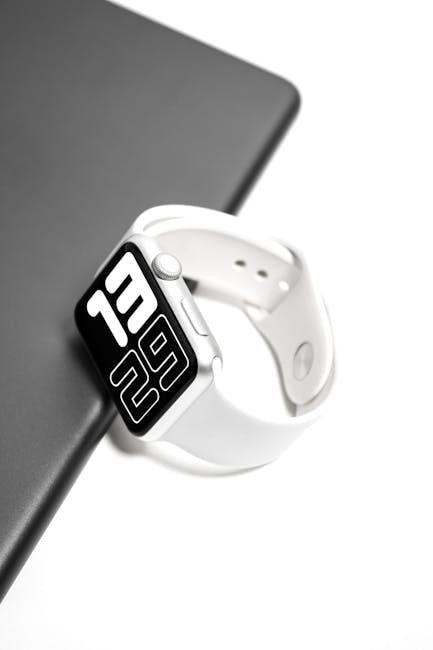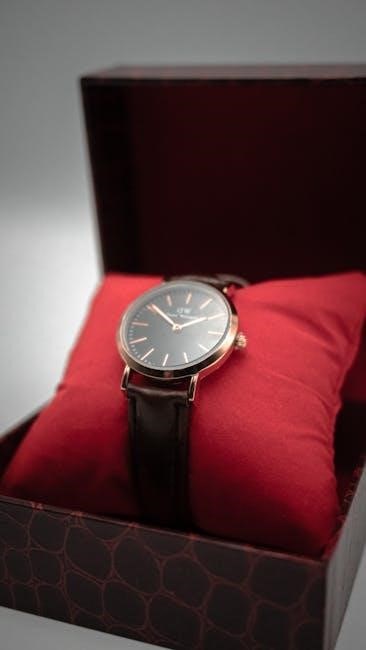Choosing the right Apple Watch case size is crucial for comfort and functionality․ With options like 40mm, 44mm, and larger models, users can find a perfect fit․ Case size impacts display visibility and overall user experience, making it a key consideration for everyday wear․
1․1 Why Case Size Matters for Apple Watch
Case size significantly impacts comfort, display visibility, and overall user experience․ Larger cases offer bigger displays for better readability, while smaller sizes provide a sleeker, more discreet look․ Proper fit ensures optimal performance, with sizes ranging from 40mm to 49mm catering to various wrist sizes and preferences, making case size selection a critical decision for both functionality and style․
1․2 Brief History of Apple Watch Case Sizes
Apple Watch case sizes have evolved significantly since their debut, starting with 38mm and 42mm options․ Over time, sizes expanded to 40mm, 44mm, and now include 45mm, 49mm, and Ultra models, offering users more choices to fit their wrists and preferences while enhancing display quality and durability․
Evolution of Apple Watch Case Sizes
Apple Watch case sizes have grown from 38mm and 42mm to include 40mm, 44mm, 45mm, and 49mm options, offering users more flexibility and improved display quality․
2․1 Historical Overview of Case Size Changes
Apple Watch case sizes have evolved significantly, starting with 38mm and 42mm, then expanding to 40mm, 44mm, 45mm, and the 49mm Ultra․ Each iteration aimed to enhance display quality and comfort, catering to diverse wrist sizes and user preferences, while maintaining a sleek, wearable design․
2․2 Latest Models: Series 8, Series 9, and Ultra
The Apple Watch Series 8 and Series 9 are available in 41mm and 45mm case sizes, offering sleek designs in aluminum and stainless steel․ The Apple Watch Ultra features a larger 49mm titanium case, designed for durability and outdoor enthusiasts․ These models provide enhanced displays, improved performance, and versatile options to suit various lifestyles and preferences, ensuring a perfect blend of style and functionality․

How to Measure Your Wrist for the Perfect Fit
Use a soft measuring tape or string to wrap snugly around your wrist․ Measure where the watch would sit, ensuring accuracy for the best fit and comfort․
3․1 Methods for Measuring Wrist Circumference
To measure your wrist, use a soft tape measure or a piece of string․ Wrap it snugly around your wrist at the point where the watch would sit, keeping the tape level and straight․ Mark or note where the end overlaps․ For accuracy, use a mirror or ask someone to help․ You can also use a printable wrist sizing tool or refer to Apple’s official size guide for precise measurements․
3․2 Tools You Can Use for Accurate Measurement
For precise wrist measurement, use a ruler or a flexible measuring tape․ Alternatively, utilize online tools or printable templates designed for Apple Watch sizing․ Some bands come with adjustable options that help determine fit; You can also visit an Apple Store for professional sizing or use a band from a previous model to gauge comfort and size accuracy․

Apple Watch Case Size Comparisons
Compare Apple Watch models like Series 8, Ultra, and SE, available in sizes from 40mm to 49mm․ Larger cases offer bigger displays, while smaller ones prioritize comfort and portability․
4․1 Size and Weight Differences Across Models
Apple Watch models vary in size and weight, with cases ranging from 40mm to 49mm․ The Ultra model, at 49mm, is the largest and heaviest, made of titanium for durability․ Smaller models, like the 40mm, are lighter and more compact, offering a comfortable fit․ Larger cases provide bigger displays but may feel bulky for smaller wrists, while smaller ones prioritize portability and everyday wear․
4․2 Display Size Variations and Their Impact
Larger Apple Watch cases, such as the 49mm Ultra, feature bigger, brighter displays for enhanced readability․ Smaller cases, like the 40mm, offer a more compact design․ Display size directly affects user experience, with larger screens improving visibility and smaller ones prioritizing discreet wear․ The choice between display sizes often depends on personal preference, with larger screens ideal for functionality and smaller ones for everyday style․

Choosing the Right Case Size for Your Needs
Consider wrist size, display preference, and practicality when selecting your Apple Watch case size․ Smaller wrists benefit from 40mm or 41mm cases, while larger wrists suit 45mm or 49mm models․ Ensure comfort and usability by matching your lifestyle and display needs for an optimal experience․
5․1 Factors to Consider: Wrist Size, Display Preference, and Practicality
Wrist size is a primary factor, with smaller wrists suiting 40mm or 41mm cases, while larger wrists fit 45mm or 49mm models․ Display preference matters for visibility, with larger cases offering clearer screens․ Practicality, such as durability for active lifestyles or material comfort, also plays a role in ensuring the best fit and user experience for everyday wear․
5․2 How to Match Your Lifestyle with the Right Case Size
Active users may prefer larger cases like 45mm or 49mm for durability and visibility․ Smaller wrists benefit from 40mm or 41mm cases for a sleek fit․ Display preference and practicality, such as screen clarity for outdoor use or style for formal events, ensure the case size aligns with your lifestyle, enhancing comfort and functionality for daily wear․

Apple Watch Case Materials and Their Impact on Size
Aluminum, stainless steel, and titanium cases vary in weight and durability, influencing size perception․ Material choice affects comfort and aesthetics without changing dimensions, ensuring a tailored fit․
6․1 Aluminum vs․ Stainless Steel vs․ Titanium
Apple Watch cases come in aluminum, stainless steel, and titanium, each offering unique benefits․ Aluminum is lightweight and affordable, while stainless steel provides durability and a premium feel․ Titanium combines strength and lightness, making it ideal for active users․ These materials don’t alter case dimensions but impact weight, comfort, and aesthetics, allowing users to choose based on lifestyle and personal preference․
6․2 How Material Affects Weight and Comfort
Material significantly impacts the weight and comfort of Apple Watch cases․ Aluminum is the lightest, making it ideal for everyday wear, while stainless steel offers durability but adds slight heft․ Titanium balances strength and lightness, providing a premium feel without sacrificing comfort․ Each material caters to different preferences, ensuring a seamless and enjoyable user experience tailored to individual lifestyles and needs․

Band Compatibility Across Different Case Sizes
Band compatibility varies by case size, ensuring a secure fit․ Smaller cases (38mm, 40mm, 41mm) share interchangeable bands, while larger cases (42mm, 44mm, 45mm, 46mm) have specific compatibility, maintaining style and functionality across different Apple Watch models․
7․1 Understanding Band Interchangeability
Apple Watch bands are designed for compatibility across specific case sizes․ Bands for 38mm, 40mm, and 41mm cases are interchangeable, while 42mm, 44mm, 45mm, and 46mm bands share compatibility within their size groups․ This flexibility allows users to switch styles easily, maintaining both comfort and aesthetic appeal․ Always ensure the band matches your case size for a secure and proper fit, enhancing overall wearability and functionality․
7․2 How to Ensure the Right Band Fit for Your Case Size
To ensure a proper band fit, measure your wrist circumference accurately using a flexible tape or string․ Compare it to Apple’s size guide to determine your ideal case size․ Bands for 38mm, 40mm, and 41mm cases are interchangeable, while 42mm, 44mm, 45mm, and 46mm bands fit specific sizes․ Always choose bands designed for your case size to guarantee a secure, comfortable, and functional fit․

Best Apple Watch Case Sizes for Different Wrist Sizes
Smaller wrists (130-150mm) suit 40mm or 41mm cases, offering a balanced look․ Larger wrists (160-210mm) pair well with 45mm or 46mm cases for a proportional fit․
8․1 Recommendations for Smaller Wrists
For smaller wrists (130-150mm), Apple recommends the 40mm or 41mm case sizes․ These sizes provide a sleek, balanced look without overwhelming the wrist․ The 40mm Apple Watch SE and 41mm Series 9 are ideal choices, offering a compact design and comfortable fit․ These models ensure optimal display visibility and a lightweight feel, making them perfect for everyday wear․
8․2 Ideal Sizes for Larger Wrists
For larger wrists (160-210mm), Apple offers case sizes like 44mm, 45mm, and 46mm, providing a more prominent display and enhanced readability․ The 45mm Series 9 and 49mm Ultra are excellent choices, balancing style with functionality․ These larger models ensure comfort and a natural fit, making them ideal for those with bigger wrists while maintaining a sleek, modern aesthetic․

How to Determine Your Apple Watch Size
Measure your wrist circumference using a flexible tape or string․ Choose a size that fits comfortably, ensuring the watch isn’t too tight or oversized for your wrist․
9․1 Using Apple’s Official Size Guide
Apple’s official size guide provides a detailed chart to help determine the perfect case size․ Measure your wrist circumference using a flexible tape or string, then compare it to Apple’s size chart․ The guide offers specific ranges for each case size, ensuring a comfortable and secure fit․ Match your measurement to the corresponding case size for an optimal wearing experience․ Try on a watch if possible for the best fit, and use Apple’s tool for accurate sizing․
9․2 Alternative Methods for Size Determination
Besides Apple’s guide, you can measure your wrist with a flexible tape or string․ Wrap it snugly, mark the overlap, and compare to a ruler․ Alternatively, use a printable size template or measure an existing watch; These methods help determine your ideal case size without official tools, ensuring a comfortable and accurate fit for your Apple Watch․

Apple Watch Size Chart: A Detailed Overview
Explore a comprehensive size chart detailing Apple Watch dimensions, weights, and case sizes across models like Series 8, 9, and Ultra․ Compare 41mm to 49mm cases, materials, and wrist circumference ranges for a tailored fit, ensuring optimal comfort and functionality based on your preferences and lifestyle needs․
10․1 Dimensions and Weights of Each Model
The Apple Watch Series 9 comes in 41mm (32․9g) and 45mm (38․8g) sizes, while the Ultra features a 49mm case (61․3g)․ The SE model offers 40mm (26․4g) and 44mm (32․9g) options․ Dimensions vary slightly across materials, with aluminum being lighter than stainless steel or titanium․ Each model’s weight and size cater to different wrist sizes and user preferences, ensuring a comfortable and functional wear․
10․2 Wrist Circumference Ranges for Each Case Size
Apple Watch case sizes correspond to specific wrist circumference ranges․ The 40mm and 41mm models suit wrists measuring 130–180mm, while the 44mm and 45mm options fit wrists between 140–210mm․ The 49mm Ultra model accommodates larger wrists, ranging from 150–220mm․ These ranges ensure a comfortable and secure fit, allowing users to choose the ideal size based on their wrist measurements for optimal comfort and functionality․

Tips for Ensuring the Perfect Fit
Measure your wrist accurately, choose the right case size, and adjust bands for a snug, comfortable fit․ Ensure the watch isn’t too tight or loose for optimal performance and comfort․
11․1 Adjusting Bands for Comfort and Security
Adjusting Apple Watch bands ensures a snug, secure fit․ Use the S/M or M/L options on Sport Bands for proper sizing․ For a perfect fit, tighten the band so it’s snug but not restrictive․ Experiment with different holes to find the most comfortable position․ Avoid overtightening, as it may cause discomfort․ Regularly check and adjust the band to maintain optimal comfort and security throughout the day․
11․2 Avoiding Common Fitting Mistakes
Avoid common fitting errors by ensuring your Apple Watch isn’t too tight or too loose․ Overtightening can restrict blood flow, while a loose fit may cause discomfort․ Measure your wrist accurately and choose the right band size․ Don’t overlook the importance of wrist shape and personal comfort preferences․ Proper fitting ensures optimal performance and all-day wearability without compromising style or functionality․
Impact of Case Size on Apple Watch Features
Larger cases enhance display clarity, improving functionality and overall user experience, while battery life remains consistent across sizes, ensuring optimal performance regardless of case size․
12․1 Battery Life and Performance Across Sizes
Battery life remains consistent across Apple Watch case sizes, with larger models like the 49mm Ultra offering slightly improved longevity due to increased capacity․ Performance stays uniform, ensuring seamless functionality regardless of size, though display size may affect perceived responsiveness․ The Apple Watch Ultra, with its enhanced features, maintains optimal performance while delivering extended battery life compared to smaller models․
12․2 Display Clarity and User Experience
Larger Apple Watch case sizes, such as 49mm, offer enhanced display clarity and better visibility, making text and graphics sharper․ This improves readability, especially in direct sunlight․ Smaller cases, while more discreet, may require closer inspection for detailed content․ The user experience remains consistent across sizes, with intuitive navigation, though larger displays provide a more immersive interaction with apps and watch faces․
Popular Apple Watch Case Sizes and Why They’rePreferred
The 44mm and 45mm models are most popular, offering a balance of comfort and display size․ Larger cases like 49mm are favored for enhanced visibility, while smaller sizes suit petite wrists․
13․1 Most Commonly Purchased Case Sizes
The most commonly purchased Apple Watch case sizes include 40mm, 44mm, 41mm, and 45mm․ These sizes cater to a wide range of wrist sizes, with 40mm and 41mm suiting smaller wrists, while 44mm and 45mm appeal to those preferring a larger display․ The 49mm Ultra model is also popular for its enhanced features and durability, making it a favorite among outdoor enthusiasts and those seeking a premium option․
13․2 Trends in Case Size Popularity Over Time
Over the years, Apple Watch case size popularity has shifted toward larger models․ The 44mm and 45mm sizes have gained traction for their enhanced display visibility, while the 40mm remains popular for smaller wrists․ Recent trends show increased interest in the 49mm Ultra model, catering to outdoor enthusiasts․ Smaller sizes like 41mm also maintain steady demand, reflecting diverse user preferences for style and functionality․
How to Buy the Right Apple Watch Case Size
Measure your wrist, compare with Apple’s size chart, and consider display preferences․ Try the watch on if possible to ensure comfort and proper fit before purchasing․
14․1 Steps to Follow When Purchasing
Start by measuring your wrist circumference using a tape or string․ Compare it with Apple’s official size chart to determine the ideal case size․ Consider your display preference and lifestyle needs․ Try the watch on if possible to ensure comfort and proper fit․ Finally, review the material options and band compatibility to make an informed decision that suits your style and functional requirements․
14․2 Importance of Trying Before Buying
Trying the Apple Watch before purchasing ensures a proper fit and comfort․ It allows you to assess how the case size and band feel on your wrist․ You can also evaluate display visibility and material quality in person․ This step helps avoid potential returns and guarantees satisfaction with your choice of case size and style․
Selecting the right Apple Watch case size ensures optimal comfort, functionality, and style․ Measure your wrist, consider display preferences, and try models before buying for the best fit․
15․1 Summarizing Key Points for the Perfect Fit
Measuring your wrist accurately is essential for selecting the ideal Apple Watch case size․ Consider both comfort and display visibility, as larger sizes offer a clearer view while smaller sizes suit slimmer wrists․ Ensure band compatibility and try models before purchasing to guarantee a seamless fit tailored to your lifestyle and preferences for optimal comfort and functionality․
15․2 Final Tips for Making the Best Choice
Measure your wrist accurately and consider your lifestyle needs when selecting a case size․ Prioritize display size for visibility or opt for a slimmer fit․ Ensure band compatibility and test the watch on your wrist if possible․ Balance aesthetics, comfort, and functionality to make an informed decision that enhances your daily experience with the Apple Watch․
